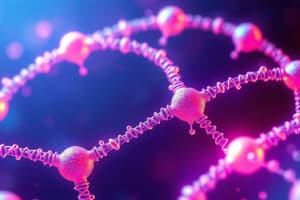Podcast
Questions and Answers
What is the primary solvent used in hydrothermal synthesis?
What is the primary solvent used in hydrothermal synthesis?
What is an advantage of hydrothermal synthesis?
What is an advantage of hydrothermal synthesis?
Which factor does NOT influence hydrothermal synthesis?
Which factor does NOT influence hydrothermal synthesis?
Which of the following is an application of hydrothermal synthesis?
Which of the following is an application of hydrothermal synthesis?
Signup and view all the answers
What is the typical temperature range used in hydrothermal synthesis?
What is the typical temperature range used in hydrothermal synthesis?
Signup and view all the answers
Flashcards
Hydrothermal synthesis
Hydrothermal synthesis
A method to make materials, like tiny particles, using hot water.
Materials made by hydrothermal synthesis
Materials made by hydrothermal synthesis
Nanoparticles, nanorods, and other small structured materials.
Autoclave in hydrothermal synthesis
Autoclave in hydrothermal synthesis
A sealed container to hold the hot water mixture.
Key factor: Temperature
Key factor: Temperature
Signup and view all the flashcards
Hydrothermal advantages
Hydrothermal advantages
Signup and view all the flashcards
Study Notes
Nanowires, Nanorods, and Nanotubes
- Nanowires are one-dimensional nanostructures with a high length-to-diameter ratio.
- Properties are determined by their mechanical properties.
- Nanorods are similar to nanowires but have a lower aspect ratio (typically less than 5:1 length to diameter).
- Nanorods also exhibit different properties due to their aspect ratio.
- Nanotubes are hollow, tube-like structures that can be single-walled or multi-walled.
Nanotubes
- Nanotubes are tiny cylindrical structures with nanometer-scale diameters and micrometer-scale lengths.
- Nanotubes can be made from various materials, such as carbon, boron nitride, and metals.
- Carbon nanotubes (CNTs) are the most well-known type, made of rolled-up graphene sheets.
Nanorods
- Nanorods are similar to nanowires but with lower aspect ratios, generally less than 5 micro meters in length.
- This difference in shape affects their properties.
- Examples: Long Gold Nanorods
Synthesis of Nanorods
- Various nanorods have been extensively studied, including carbon, ZnO, gold, and magnetic nanorods.
- Different synthesis techniques are used depending on the type of nanorod.
- Methods:
- Physical methods (vapor deposition, laser ablation)
- Chemical methods (chemical vapor deposition, sol-gel, hydrothermal)
- Biological methods (bacteria-assisted, template-assisted)
- The choice of method depends on the desired size, shape, and application of the nanorod.
ZnO Nanorod Synthesis
- High-oriented ZnO nanorods can be produced through chemical, electrochemical, and physical deposition techniques.
- Techniques:
- Chemical vapor deposition (CVD)
- Vapor-liquid-solid (VLS) growth
- Electrochemical deposition (ED)
- Hydrothermal approaches.
- Significant focus on VLS method for ZnO nanorod synthesis.
VLS Growth of ZnO Nanorods
- Gold (Au) nanoparticles are used as catalysts in VLS method.
- Au nanoparticles are used to promote ZnO nanorod formation.
- The high growth temperature (above 900°C) dissolves Zn vapor in the Au catalyst.
- Zinc precipitates from the catalyst droplet, oxidizing and forming ZnO nanorods.
Hydrothermal Synthesis
- A method for synthesizing materials, particularly nanorods, using high-temperature aqueous solutions.
- Steps:
- Dissolve precursors
- Heat the solution in a sealed vessel (autoclave) above the boiling point of water.
- Maintain the temperature and pressure for a specific time.
- Cool the solution, allowing the material to precipitate.
Advantages of Hydrothermal Synthesis
- Low cost and simplicity
- High-quality materials with controllable size and shape
- Environmentally friendly
Applications of Hydrothermal Synthesis
- Nanoparticles (e.g., metal oxides, quantum dots)
- Nanorods (e.g., metal oxides, semiconductors)
- Nanostructures (e.g., zeolites)
- Biomaterials (e.g., hydroxyapatite)
- Energy materials (e.g., battery electrodes)
- Catalysts
Applications of ZnO Nanorods
- Gas sensors (detect NO, NO2, CO, NH3, H2, O2, ethanol).
- The gas sensitivity is due to conductivity changes when gas molecules adsorb or desorb.
- Unique shapes enhance light absorption to generate electricity for solar cells.
Applications of Gold Nanorods
- Medical and drug delivery
- Detection of pathogens
- Imaging
- Hyperthermia
- Drug delivery, functionalization and improvement of the effectiveness of the drugs using Gold nanorods.
- Photothermal therapy (cancer treatment by converting light to heat)
- Catalysis
- Sensors for heavy metals, pathogens and small molecules.
Studying That Suits You
Use AI to generate personalized quizzes and flashcards to suit your learning preferences.
Related Documents
Description
Explore the fascinating world of nanostructures including nanowires, nanorods, and nanotubes. This quiz delves into their properties, synthesis, and applications. Learn about how aspect ratios affect their characteristics and the materials used in their creation.



